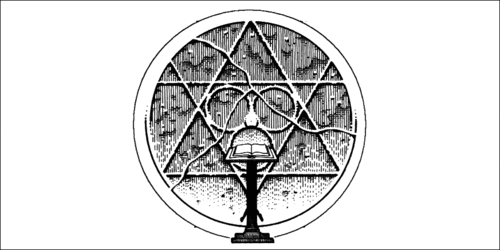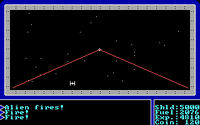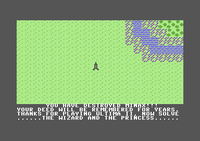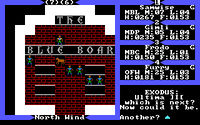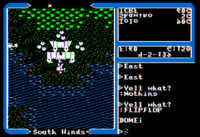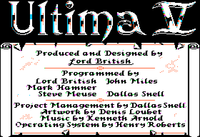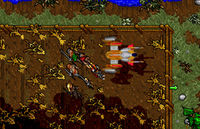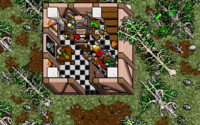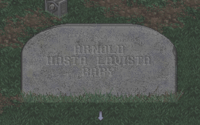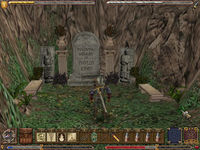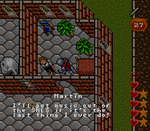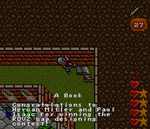Easter Eggs and Cultural References
(Redirected from Real-Life references and Easter Eggs)
Jump to navigation
Jump to search
Within the Ultima universe appears a great variety of Easter eggs and cultural references, which range from often humorous asides to significant influences on the series' fiction. The list below strives to be a definitive compilation of all such instances.
Similarly, many Ultima characters are inspired in some fashion by real-world counterparts.
Age of Darkness[edit]
Akalabeth[edit]
- Main article: Akalabeth
- The name Akalabeth derives from the fourth part of J.R.R. Tolkien's The Silmarillion, Akallabêth, which details the downfall of the continent of Númenor in the author's Middle-earth universe. The Silmarillion was published two years prior to Akalabeth's 1979 release; other than the title, however, there is little similarity between the game's plot and Tolkien's text.
- The final adversary that must be vanquished by the player is a balrog, a type of demonic monster from Tolkien's works (notably The Lord of the Rings). In the Ultima games that followed Akalabeth, these formidable beasts would come to be known instead as balrons.
Ultima I[edit]
- Main article: invert
- Many of the cities in the Lands of the Feudal Lords are named after family and friends of Richard Garriott: Owen, Helen, and Linda, after his father, mother, and sister; Arnold, after veteran Ultima programmer and musician, Ken Arnold; and Gerry, after a programmer acquaintance of Garriott's (presumably Gerry Mayer).[1]
- The eight princesses and their seemingly arbitrary imprisonment are a deliberate tribute to the "damsel in distress" cliché, seen in many fictional works.[2]
- When the Stranger uses a spaceship to become a Space Ace in Ultima I, the starfighters that must be shot down resemble Imperial TIE fighters from the Star Wars franchise.
- The second most powerful weapon in the game is the phazor, a pastiche of Star Trek's phasers.
- The Pillar of Ozymandias is a reference to the famous sonnet by Percy Bysshe Shelley. The inscription on the pillar ("I am Ozymandias, King of Kings / Look on my works, ye mighty, and despair!") is a direct quote from the poem, as is the "Nothing beside remains" comment.
- In the Apple version of Ultima I's 1986 re-release, programmer John Miles included a routine whereby waiting for the title screen's animated sequence to loop a number of times causes two alternate events to occur. With every fourth repeat of the sequence, an armoured knight rides along the medieval landscape's horizon; however, every fourth time this knight is scheduled to appear (i.e. after sixteen loops), a red Lamborghini is instead shown approaching the depicted castle and entering through its open door. Each of these animations can also be manually triggered when the small white Origin logo is shown against the landscape: pressing Control+K causes the knight to appear, while pressing Control+Shift+P on the Apple version or Control+Shift+2 on the Apple IIe introduces the Lamborghini. It is possible to perform each command in quick succession to display both the rider and sports car simultaneously.[3]
- The last overworld tile in the 1987 MS-DOS remake's T1KTILES.BIN file is pixel art of Spuds MacKenZie, the brand mascot for American beer Budweiser from 1987 to 1989.
Ultima II[edit]
- Main article: Ultima II: The Revenge of the Enchantress
- Several real-world corporations are lampooned in the game:
- Global fast food chain McDonald's appears as McDonall's in Port Bonifice and is operated by a Ronall Mc Donall. It stocks food that can be stolen from its take-out window.
- A Jack in the Box restaurant appears as Jack in de Box in the village of New Jester on Uranus.
- American retail chains Sears and Montgomery Ward (now defunct) feature as a group of oracles (i.e. "seers") in New Jester. The latter store appears as Monkey Ward, its common nickname at the time.
- Richard Garriott appears as himself in the Computer Camp on Neptune; his father, Owen, also appears in Towne Mary on Mars, and Towne Linda is named after his sister.
- John and Geraldine "Gerry" Mayer , the married part-owners of the ComputerLand store where Garriott worked while coding Akalabeth,[4][5][6] appear in Towne Linda's Transport shop. The Mayers were instrumental to Garriott's early success in the video game industry, as their suggestion that he self-publish Akalabeth and sell it at the store quickly led to California Pacific approaching the young developer with a nationwide distribution deal.
- Andrew Greenberg and Robert Woodhead, co-creators of the competing CRPG series, Wizardry, can be found in Le Jester tending a shop named after their creation.
- The town of Tommersville on Pluto is an homage to the popular early-1980s Apple II magazine Softalk. The publication's co-founders, Margot and Al Tommervik, appear in the town's Softalk store, while the wizardry shoppe, Kurts, is named after magazine contributor Kurt Wahlner.
- Waren Beatty [sic] makes an appearance in Pirates Harbour asking for Diane Keaton.
- Certain key concepts in Ultima II, such as the time doors (the precursor to moongates), the cloth map showing how they interconnect, and the Time of Legends, are directly inspired by Terry Gilliam's 1981 film, Time Bandits.[7]
- A Commander Decker frequents Castle Britannia's mess hall and screams something inscrutable about soup. This might be an allusion to Commander Willard Decker, a character who appeared in Star Trek: The Motion Picture a few years earlier.
- Planet X might be a reference to the classic Looney Tunes short Duck Dodgers in the 24½th Century, or to a theorized planet in the solar system, disproved later in the 1980s.
- Various pictograms are formed by the clusters of trees in New Jester, including the titular protagonist of Pac-Man and one of its ghost enemies.
- In Castle Britannia there is a character named Sister Sledge, after the popular disco group. This cleric's only response is to sing "We Are Family!" in reference to the group's breakthrough 1979 hit, which went on to serve as the anthem of that year's Pittsburgh Pirates.
- There is a hotel in New San Antonio named Hotel California, after the best-selling Eagles album Hotel California and its title track.
- 666, the "Number of the Beast" from the biblical Book of Revelation, is found two times in the game: it appears as a rock formation in Pirates Harbour, and again as the coordinates for Earth.
- The ending on the C64 also promotes an On-Line Systems (that will later become Sierra) game called "Wizard and The Princess."
Ultima III[edit]
- Main article: Ultima III: Exodus
- A metafictive line is sometimes given by bartenders in the game: "EXODUS: Ultima ]I[, which is next? Now could it be."
- In the Nintendo version, a woman in Lord British's castle asks if the party are descendants of Link, the protagonist of Nintendo's The Legend of Zelda series. In the same release, Richard Garriott can be found in Montor West. He will ask if the player knows him, and if answered "no", responds with "I made Ultima." Should he be spoken to again, he will say: "Believe it or not, I'm Richard Garriott."
Age of Enlightenment[edit]
Ultima IV[edit]
- Main article: Ultima IV: Quest of the Avatar
- Skara Brae is named after a prehistoric settlement on the west coast of Orkney in northern Scotland. In addition to the Ultima series, cities named Skara Brae also appear in the universes of Wizardry and The Bard's Tale; this commonality arose from the contributions to all three series of designer Roe R. Adams III, whose fictional counterpart, Hawkwind, is purported to hail from the town.[8]
- Characterizations of historical figures Siddhārtha Gautama (Buddha) and Michelangelo di Lodovico Buonarroti Simoni can be found in Skara Brae. Buddha is described as a great philosopher, while Michaelangelo's maxim, "May thou always desire more than thou can accomplish", paraphrases a quote of the famed Renaissance artist.
- Dickens in Skara Brae is a tribute to 19th-century author Charles Dickens. The character presents himself as a storywriter and will paraphrase the real-world Dickens novel, Our Mutual Friend.
- Paul McCartney and two of his albums, Pipes of Peace and Tug of War, are referenced on multiple occasions throughout the game, having been favorites of Richard Garriott at the time:[9]
- The tagline on the title screen ("In another world, in a time to come.") is taken from McCartney's song, "Tug of War".
- The singer himself appears in Cove with his wife, Linda McCartney, as Paul and Linda. The two sing lines from the ex-Beatle's song, "Pipes of Peace".
- Rabindranath Tagore, the Bengali poet from whom McCartney drew inspiration when writing "Pipes of Peace", is also present in Cove.
- Short Round, from Indiana Jones and the Temple of Doom, is found in Yew. He says he is working for "Jones" and "Indy" is currently on an adventure.
- In the Amiga version of the game, anyone who is told the word ojnab (banjo, backwards) will reward the player with the secret number of a person named Banjo Bob by saying: "Hi Banjo Bob! Your secret number is 4F4A4E0A". This string of characters is the hexadecimal for "OJN", the last three letters in the aforementioned "ojnab". "Banjo" Bob Hardy is the author of the Amiga version of Ultima IV.
- The need for a bell, book, and candle in order to open the Abyss is a reference to a method of excommunication of the Catholic Church. Other video games, such as Zork and NetHack, also make use of these three items in order to access evil or hell-related places.
- Pressing Control+S will reveal all the player's progress values for the Eight Virtues. This spared the game's designers and playtesters from having to continually return to the castle and ask Hawkwind about their statuses in each Virtue.
Ultima V[edit]
- Main article: Ultima V: Warriors of Destiny
- In the city of Skara Brae there is a tombstone that reads, "Here Lies the Tale End of a Bard." This epitaph refers to Skara Brae's mutual inclusion in both the Ultima series and The Bard's Tale, which for a period shared a designer in Roe R. Adams III.
- Tika, the barmaid of Britain's Wayfarer Inn, is named after Tika Waylan from the Dragonlance novels.[10]
- The horse keeper in Trinsic is named Hettar, after one of Belgarion's companions in the David Eddings fantasy series The Belgariad and The Malloreon.
- Emilly in Stormcrow will mention her husband's dead friend was named "Scotty" and he had spoken about a "beam", in reference to James Doohan's character in Star Trek, Montgomery "Scotty" Scott.
- The farmer Christopher in the Britannys talks about a fantasy work he is writing, called Times of Lore. This character is the Britannian counterpart of prominent Origin designer Chris Roberts, who created the company's 1988 action role-playing game, Times of Lore, before going on to conceive his magnum opus, the Wing Commander series. Cross-promotion of other Origin titles would continue in future Ultima installments.
- Goeth, the council member in Jhelom who speaks in reverse, might be a reference to German polymath Johann Wolfgang von Goethe.
- When describing himself in conversation, Chuckles claims to be "trustworthy, loyal, helpful, friendly, courteous, kind, obedient, cheerful, thrifty, brave, clean, and reverent." He is quoting the Scout Law of the Boy Scouts of America.
- If any characters are sworn at during a conversation, they will scold the player. The list of recognized obscenities is comprehensive and can be found by hex-editing the Ultima V data files: in the DOS version, it is located in the file DATA.OVL. Notably, the final phrase to appear in this profanity list is "ELECTRONIC ARTS", a pointed response to founder Trip Hawkins' refusal to address Richard Garriott's allegations of plagiarism against their 1987 release, Deathlord.[11] Hawkins himself appears as a shipwright in East Britanny, and would later inspire a prominent role in the mythology of Ultima VI.
- A horse for the Avatar will be created should one be wished for upon dropping a coin into a well. However, a variety possessing greatly increased speed can also be granted by wishing for "corvette", "ferrari", "lamborghini", "lotus", or "porsche".
- Yelling "FLIPFLOP" in the Apple II version of the game causes each tile on the screen to invert itself, top to bottom; yelling it again restores the view to normal. During development, this subroutine was installed on Richard Garriott's computer as a practical joke by composer Ken Arnold, originally to execute automatically after a few minutes of inactivity when the Ultima creator would foreseeably leave his terminal idle. After confounding Garriott, who believed it to be a bizarre program malfunction, Arnold confessed responsibility and the team liked the effect so much they left it in the game.[12]
- In the Apple version of the Acknowledgments screen, pressing Shift+Ctrl+6 will cause Toshi Morita's name to disappear. This stems from a subroutine inserted by Morita himself, in which the command would trigger the appearance of a flashing arrow next to his name in the list of credits. When Morita left Origin prior to the release of Ultima V, however, his colleagues discovered his surreptitious code and, as a joke, rewrote it so his name would be erased instead.
- The magical harpsichord in Lord British's chambers can not only make the designated section of wall disappear, but also transform objects put in its place.
- When a giant rat is Looked at, the player will see "a rodent of unusual size" - an obvious reference to the book and movie, The Princess Bride.
Ultima VI[edit]
- Main article: Ultima VI: The False Prophet
- The first introduction sequence contains several items of note:
- The television being watched by the Avatar can have its channel manually changed by pressing a corresponding number on the keyboard. At the time of release, the phone number displayed during the televangelist segment belonged to Origin's customer service department.
- The digital clock above the Avatar's television displays the system time of the player's computer.
- A can of Coca-Cola is on the side table, along with a copy of the Stephen King horror novel, It (parodied here as If).
- The paintings hanging to either side of the entertainment center are depictions of two real pieces: the first is a 1986 airbrush painting by Ultima VI artist Keith Berdak,[13] while Denis Loubet's Ultima V cover art is shown when the view pans to the back window. Berdak's work replaced an illustration of a woman by Patrick Nagel, which can be seen in a screenshot on the back of the Ultima VI box.
- The discarded pizza box on the floor is styled after that of Domino's Pizza, instead with a logo incorporating a checkerboard.
- The marginally-visible album cover is purportedly based on artwork produced for new wave band Devo, possibly from their 1981–1982 New Traditionalists tour merchandise and "Beautiful World" single, or their Q. Are We Not Men? A: We Are Devo! album.[14] The cover seen in Ultima VI does not appear to be an exact match for any of these, however.
- The Avatar is modeled on playtester John Watson.[15]
- The title screen's accompanying music can be substituted with other pieces from the game by pressing numbers on the keyboard, which correspond as follows:
- 1: "The Ultima Theme" (default)
- 2: "Can't Remove the Pain" (first introduction sequence)
- 3: "Fall Leaves" (second introduction sequence)
- 4: "I Hear You Crying" (character creation)
- 5: "Black Forest" (wandering theme)
- 6: "Captain John's Hornpipe" (sailing theme)
- 7: "Engagement and Melee" (combat theme)
- 8: "Stones"
- 9: "The Wander" (dungeon theme)
- 0: "Rule Britannia"
- Terran books Alice in Wonderland by Lewis Carrol, Hubert's Hair-Raising Adventure by Bill Peet, and The Wizard of Oz by L. Frank Baum appear in Britannia. Asking Lord British about books will reveal he has long sought a copy of the Baum classic; should it be obtained from the Lycaeum and presented to him, he will reward the Avatar with a number of peer gems.
- The events of Origin titles Knights of Legend, Tangled Tales: The Misadventures of a Wizard's Apprentice, and Windwalker are chronicled in Britannia as books. Seggallion, a major character from Knights of Legend, can also be found in Serpent's Hold and will recount his previous experiences in the Knights setting of Ashtalarea.
- The Caverns of Freitag, a 1982 CRPG developed for MUSE Software by David Shapiro (a.k.a. Dr. Cat), is referenced both as a book and in the exploits of Gertan, a fighter in Cove reputed to have slain the game's eponymous dragon and donated its remains to Britain's Royal Museum.
- By 1990, Richard Garriott had come to regard Electronic Arts and its founder Trip Hawkins with considerable animosity, having accused the corporation of plagiarizing the Ultima series in 1987 before finding himself targeted by them with a frivolous lawsuit designed to force Origin into paying an out-of-court settlement.[11][16] These incidents inspired Garriott to include a sardonic tribute to Hawkins, as well as other senior Electronic Arts personnel, in the form of reviled pirate Captain Hawkins (who stole Captain Johne's Silver Tablet before being murdered by his own crew) and three of his crewmates: Alastor Gordon (Bing Gordon), Bonn (Stewart Bonn), and Old Ybarra (Joe Ybarra).
- The Pushme Pullyu originates from Hugh Lofting's The Story of Doctor Dolittle, in which it is described as a "gazelle-unicorn cross"; in the 1967 film adaption, Doctor Dolittle, it appears as a two-headed llama.
- Several crypts in the Moonglow Catacombs are dedicated to members of the Ultima VI development team: Bourbonnais (artist Dan Bourbonnais), Cantrell (playtester Steve Cantrell), Malone (either playtester Paul Malone or Compendium writer Greg Malone), Romero (playtester Mike Romero), and Spector (co-producer Warren Spector).
- Burma-Shave, a defunct American brand of brushless shaving cream, is lampooned with various rhymes typical of the sequential highway signs with which the company advertised itself from the mid-1920s to the early 1960s. Three such poems appear on tombstones in the Empath Abbey graveyard, while Horance will respond to the input "Burma Shave" with one of his own.
- Real artworks and artists are referenced in paintings found throughout Britannia:
- Ascending and Descending by M. C. Escher
- The Treachery of Images by René Magritte
- Larry Elmore: a fantasy artist who came to prominence through his contributions to Dungeons & Dragons materials of the 1980s, including the Dragonlance setting and covers for its first three novels. Elmore also painted the cover art for Origin's 1990 action role-playing game, Bad Blood.
- Helen Garriott: Richard Garriott's mother, who provided art for the original cover of Akalabeth and the cloth map included with Ultima III.
- Monica Knighton: an illustrator and friend of Ultima VI writer David Shapiro (Dr. Cat). Knighton also appears as the character Taynith.
- Elissa Martin: an illustrator of supplemental materials for various tabletop role-playing systems in the 1980s and 1990s, particularly Rolemaster.
- Real Musgrave: a fantasy artist and co-creator of the Pocket Dragons line of collectibles.
- The blue star worn by Nicodemus and Thariand is a reference to fantasy author Marion Zimmer Bradley’s Lythande anthology, in which the foreheads of mages are tattooed with a blue pentagram.
The Savage Empire[edit]
- Main article: Worlds of Ultima: The Savage Empire
- The Savage Empire’s premise draws inspiration from such sources as Sir Arthur Conan Doyle's The Lost World and pulp hero Doc Savage.
- The Three Stooges appear as Disquiqui Tribe members Chafblum, Larrifin, and Tuomaxx. Chafblum will react with vague recognition to the Avatar mentioning "Three Stooges", "Moe", "Larry", or "Curly". The Spear of Shamap is a reference to Shemp, called the "fourth Stooge."
- A parrot named Cleese resides in the palace of the Nahuatla Tribe. The bird is named after Monty Python alumnus John Cleese, who is famous for a skit involving a dead Norwegian Blue parrot.
- Denys, the Urali outcast painter, is the in-game counterpart of veteran Ultima artist Denis Loubet.
- When looking at the cave maps in a map viewer, the letters "SMB" become visible in an unreachable location. They are the initials of worldbuilder Stephen Beeman.
Martian Dreams[edit]
- Main article: Worlds of Ultima: Martian Dreams
- Martian Dreams is inspired by such Victorian era science fiction works as H. G. Wells' The Time Machine and, particularly, Jules Verne's From the Earth to the Moon, in which a group of gun enthusiasts endeavor to make a moon landing by similarly firing themselves from a space cannon.
- In the introduction sequence there is a poster of the Ultima VI box art hanging in the Avatar's house, complete with the title logo.
- If Dr. Spector is asked about spam, he will say he enjoys eating it. This is in reference to the "spam, spam, spam, humbug" cheat code in Ultima VI.
- If the player goes into solo mode with Dr. Spector and attempts to make him repair the wiring at the power station, he will shout Avon's "I am not expendable" tirade from Blake's 7.
- The appearance of Chsheket's bare mechanical form may have been inspired by the Maschinenmensch from Fritz Lang's pioneering science-fiction film, Metropolis.
- Dorothy's iconic ruby slippers from The Wizard of Oz are buried among the glaciers south of Hellas. When used, they offer a chance to view the game's ending sequence; if the player chooses not to, a brief view of a Kansas wheat field is shown instead.
- Using a map viewer reveals the name "GRYPHON" carved into the northeastern glacier, which is normally unreachable. It is the nickname of Philip Brogden, the game's principal world designer.
Ultima Underworld[edit]
- Main article: Ultima Underworld: The Stygian Abyss
- The Cup of Wonder and the tuneful process of its discovery refer to the eponymous song by British progressive rock band Jethro Tull, who are famously recognized for their use of the flute.
- On the fifth level, there is a small maze where a substance can be gathered simply by walking over it. The location features four powerful ghosts and teleporters on the sides, and is conspicuously similar to a Pac-Man level.
- The Book of Honesty by Ravenhurst of Moonglow is a reference to the Honest Book of Truth that (in the Principia Discordia) was given to an Omar Khayyam Ravenhurst, a pseudonym of Kerry Wendell Thornley.
- There is a non-hostile dire ghost in the southwest of the sixth level which, upon examination, is revealed to be "a spectre named Warren." This is a pun referring to Warren Spector, producer of Ultima Underworld and a number of other Ultima titles.
- An inscription carved into the wall of the eighth level reads, "Thou canst not defeat the Drakhri!" In Origin's Wing Commander II, an oft-repeated battle cry of the Kilrathi is, "You cannot defeat the Drakhai!"
Age of Armageddon[edit]
Ultima VII[edit]
- Main article: Ultima VII: The Black Gate
- In the introduction sequence, the Ultima VI box and cloth map can be seen beside the Avatar's computer monitor, along with an ankh amulet and Orb of the Moons beside the mouse.
- The Fellowship's procedures and practices emulate many new age religious movements, including Scientology. Its leader, Batlin, bears some similarity to Scientology founder L. Ron Hubbard.
- The Guardian's three prismatic blackrock generators, as well as subordinates Elizabeth and Abraham (initials "E" and "A"), may be a deliberate reference to Electronic Arts. Richard Garriott has given conflicting accounts both denying and acknowledging such an intention.[17][18]
- Jesse, one of the actors at Britain's Music Hall, carries a troll doll, which can be discovered only by killing the actor and searching his corpse.
- Playwright Raymundo's Three on a Codpiece, written for Jesse, is likely a reference to Yoko Ono's famous conceptual happening Cut Piece, in which members of the audience were instructed to cut off the artist's clothing while she sat on stage.
- Candice, the curator of Britain's Royal Museum, names five real artists as exhibitors:[19] Ultima VII writer-designer John Watson, who contributed art to several Origin titles; Richard Fox, who was commissioned to paint a portrait of Garriott in the mid-1980s and is paid tribute in Ultima VI as Captain Fox; Randi Frank, Ultima VII lead writer Raymond Benson's wife and the inspiration for Miranda; Ultima VII artist Glen Johnson, upon whom Glenno is based; and veteran Ultima artist Denis Loubet, who appears in Ultima V and Ultima VI as Loubet).
- On the eastern outskirts of Britain, a Kilrathi Bloodfang starfighter is hovering in the corn field of farmer Mack, who can recount his tale of a cat-like being emerging before he killed and ate it. This is the actual Bloodfang ship graphic from Origin's Wing Commander II, and double-clicking it triggers a performance of that game's "Kilrathi Theme".
- Northwest of Cove is a flower field that will cause the Avatar and all companions to fall asleep if they walk through it, re-enacting a scene from The Wizard of Oz.
- Two miners in Dungeon Covetous are Malloy and Owings, whose appearance and behavior are a satire of Laurel and Hardy.
- In Serpent's Hold, many of the inhabitants are explicitly modeled after the crew of the USS Enterprise in Star Trek: The Next Generation:
- Lord John-Paul: Jean-Luc Picard (John-Paul is a bald leader figure)
- Sir Richter: William Riker (Richter is Second-in-Command to John-Paul)
- Sir Horffe: Worf (Horffe, the Captain of the Guard, is a gargoyle raised by humans)
- Sir Denton: Data (Denton is highly astute but emotionally vacant, with a stale sense of humor and perpetually clad head-to-toe in plate armour)
- Lady Leigh: Beverly Crusher (Leigh is a red-haired healer)
- Lady Tory: Deanna Troi (Tory is remarkably empathetic and provides guidance to those at the Hold)
- Sir Jordan: Geordi La Forge (Jordan is a blind but perceptive tinker who wears a headband over his eyes)
- In early drafts of Ultima VII, Tasha Yar is also referenced in the form of a blonde, female paladin named Sir Yarina.[20]
- In Skara Brae there is a homage to J.R.R. Tolkien in the cemetery. The plaque beneath the statue near Marney's crypt reads, "JRRT / A great man / A great writer."
- There is a dead crocodile in Hook's subterranean hideout on Buccaneer's Den. Examination of the carcass reveals a pocketwatch, in reference to Captain Hook's encounter with a crocodile in Peter Pan.
- Several satirical references appear as books:
- Struck Commander by Gilberto is a play on Origin's combat flight simulator, Strike Commander.
- Mandibles by Peter Munchley is a parody of Jaws by Peter Benchley.
- Magic and the Art of Horse-and-Wagon Maintenance is the Britannian version of Robert M. Pirsig's Zen and the Art of Motorcycle Maintenance.
- Everything an Avatar Should Know About Sex is a parody of Dr. David Reuben's Everything You Always Wanted to Know About Sex* (*But Were Afraid to Ask)
- Gone with the Wisp by Margareta Mitchellino is loosely based on Margaret Mitchell's Gone with the Wind.
- Encyclopedia Britannia is a spoof of Encyclopædia Britannica.
- Gargoyle Like Me by Darok is an adaptation of Black Like Me by John Howard Griffin.
- Brommer’s Britannia, Brommer’s Fauna, and Brommer’s Flora echo the Frommer’s series of travel guides.
- Birds of Britannia by Brother Wayne is analogous to The Birds of America, a pioneering work in wildlife illustration completed between 1827 and 1838 by French-American naturalist and painter John James Audubon.
- How the West Was by Yuclydia refers to How the West Was Won, a film and television series.
- The Summer of My Satisfaction by Plexes is the polar opposite, both in title and story, of William Shakespeare’s Richard III, whose opening lines, "Now is the winter of our discontent / Made glorious summer by this sun of York", gave name to The Winter of Our Discontent by John Steinbeck.
- The Trio by Leepeartson, a collection of songs by "three master bards", is a tribute to progressive rock band Rush, the author's name a portmanteau combining the surnames of band members Geddy Lee, Neil Peart, and Alex Lifeson.
- What a Fool Believes by P. Nolan is named after a song by The Doobie Brothers.
- Many in-game books are real-world literary works:
- Hubert's Hair-Raising Adventure by Bill Peet
- Ringworld by Larry Niven
- Stranger in a Strange Land by Robert A. Heinlein
- The Wizard of Oz by L. Frank Baum
- Chitty-Chitty-Bang-Bang by Ian Fleming
- Play Directing: Analysis, Communication and Style by Francis Hodge
- On Acting by Laurence Olivier
- The Transitive Vampire by Karen Elizabeth Gordon
- Key to the Black Gate by Andrew P. Morris
- Ultima: The Avatar Adventures by Rusel DeMaria and Caroline Spector
- Collected Plays by Raymundo contains The Plagiarist, Clue, and Thumbs Down, three real works by lead writer Raymond Benson, the inspiration for Raymundo.
- Other books are written by authors whose names are puns:
- The Silence of Chastity by I.M. Munk (I am monk)
- What Could Be Left But The Ashes by N. Flaims (in flames)
- Lord British can be killed at noon each day, when he stands directly under the brass plaque mounted above the doorway to his throne room: double-clicking this plaque will cause it to fall and decapitate him. This grisly feat is patterned after an actual incident at Origin headquarters, in which the armature plate from an electromagnetic door lock fell from its mounting and struck Richard Garriott's head. The companions' subsequent exclamation, "Yancey-Hausman will pay!", refers to the company responsible for the maintenance of Origin's office building at the time.[21]
- Should the player succeed in murdering Lord British, searching his corpse uncovers the late king's will, in which he reveals an affair with his maidservant Nell and claims fatherhood of her unborn child. According to Richard Garriott, this particular Easter egg did not receive his approval for inclusion.[22]
- In the Super Nintendo version only, there is a character in the guild hall of Minoc named Lucas. He bears a striking resemblance to George Lucas, the creator of Star Wars.
- The crucifixion of Christ is re-enacted at Stonegate, complete with a cape, a cup full of blood and a spear. However, unlike the biblical scene, there are several more crucified corpses in the surrounding area.
Ultima Underworld II[edit]
- Main article: Ultima Underworld II: Labyrinth of Worlds
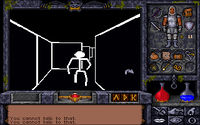
Ultima Underworld II's tribute to Akalabeth.
- A number of paintings in Castle Britannia are box art from previous Ultima games.
- Nystul's library and chest contain a number of real-life books:
- Sex by Madonna (this one is safely locked away).
- The Wealth of Nations by Adam Smith.
- At the Mountains of Madness by H. P. Lovecraft.
- Swords Against Death by Fritz Leiber.
- Something Under the Bed is Drooling by Bill Watterson.
- Neuromancer by William Gibson.
- Pale Fire by Vladimir Nabokov.
- Green Eggs and Ham by Dr. Seuss.
- The Wizard of Oz by L. Frank Baum.
- The Princess Bride by William Goldman.
- The library also contains some books made by Origin themselves:
- Mysteries of the Abyss, the hint book for Ultima Underworld.
- Key to the Black Gate, the hint book for Ultima VII.
- Meanwhile Lord British's chest holds eyeballs, playing at the cliche of the noble with a dark secret..
- In Killorn Keep, the Avatar encounters cat-like creatures with an apparently glorious past known as the Trilkhai, who the wisps later reveal were once a space-dwelling race. These beings are an allusion to the Kilrathi of the Wing Commander series, with the name Trilkhai being an anagram of Kilrathi.
- Also in Killorn Keep, male Avatars can identify themselves to Mystell as Abraham Lincoln.
- In the purple zone of the Ethereal Void, there is an homage to the early entries in the series where dungeons are displayed with vector lines (such as in Akalabeth), complete with primitively drawn enemies. There is also a goblin named A. I. Crunchowicz in this zone, a reference to the protagonist of id Software's Wolfenstein 3D, B. J. Blazcowicz.
- The sequence in which the Avatar has to recolor a pyramid in the Void five times, by jumping on each step once, is an exact replica of the puzzle-game Q-Bert (including the pads for returning to the top).
- There are a couple of subtle references in the game's dialogue to the opening of the 1967 miniseries The Prisoner. When speaking to the goblin guards of Tarna, the Avatar has the opportunity to shout "I am not a slave, I am a free man!" Later, when encountering the wisp on the ethereal plane, the entity may be asked what it wants; when the wisp replies, "We want information," the hero may in turn reply, "You won't get it!"
- On the third level of the Pits of Carnage, a hidden lair of a lich can be found. Inside is a note in which the lich mentions a "Dr. Kintobor". This plays upon an origin for Dr. Robotnik in a Sonic the Hedgehog comic book, where he, before becoming evil, used to be the kind Dr. Kintobor. Of course said origin is non-canon after Sega put stricter control on canon in the mid-ninties.
Ultima VII Part Two[edit]
- Main article: Ultima VII Part Two: Serpent Isle
- Most of the game's character portraits are based on photographs of Origin staff, their family members, and friends, while others are submissions remaining from the Immortality Contest held for Ultima VII.[23]
- In the town of Monitor, there is a heavily tattooed woman named Lydia, who specializes in tribal tattoos. Although not conclusive, it is possible that her name is a reference to the 1939 song, "Lydia the Tattooed Lady", once popularized by Groucho Marx.
- Deep within the tunnels that access the Ice Plains is the tomb of Gannt the Bard, atop which sits the key to a small, two-level dwelling in Knight's Forest known as the House of Wares. The lone resident of this facility is Captain Stokes, a software pirate who appears to be occupied with making copies of various Origin titles. Double-clicking his "glowing cube", "humming box", or "rune buttons" plays advertisements for Strike Commander, Privateer, and, much to the Avatar's trepidation, Ultima VIII. Attempting to use this computer a fourth time will cause it to explode.
- In the book The Structure of Order, there is a passage that reads, "Some will tell thee that Logic is 'a little bird chirping in a meadow' or that it is 'a wreath of flowers which smell bad'." This is a reference to the 1967 Star Trek episode, "I, Mudd", in which Spock uses irrational statements such as these to short-circuit a number of androids.
- In perhaps one of Serpent Isle's more infamous Easter eggs, the NFL's Dallas Cowboys are paid tribute in two of the game's cheat rooms. The first, hidden on the Isles of the Mad Mage, is a hedonistic and lavishly outfitted grotto adorned with a painting and lifelike statues of the team's cheerleaders. Another such tapestry is also found in the cellar accessed below the stairway to Pothos' apothecary, which leads further, via a secret passage, to a replica football field complete with a cheer squad and a "team" of ice trolls and elementals. This was created by Ultima VII Part Two artist and assistant designer Steve Powers.[23]
- Persistently double-clicking on some types of animal eventually gives farcical results. Performing this action on a cat will cause it to spontaneously explode, prompting a party member to exclaim, "Bloody cats!" If done to a sheep, the Avatar will stand behind it and appear to engage in lewd behaviour. The party will subsequently scold, "That's baaaad!" and, "Thou art SICK!"
- A glowing egg called Dave is found in the game's data files; it is presumably named after David Beyer, who is listed in the credits as "Eggman".
- When the group runs into a bunch of snakes, one of the companions eventually utter Indiana Jones' famous quote: "Snakes! Why did it have to be snakes?"
- When you repeatedly click the large mushroom on level 3 of the Abandoned Outpost (only at night and after the banes) Iolo will cite Jim Morrison "I am the Lizard King. I can do anything." while the Avatar will answer some gibberish from the cheater dialogue. Interestingly enough, this is not present in the available beta version but works in plain Serpent Isle as well as in the complete edition (including the Silver Seed Add-on)
Ultima VIII[edit]
- Main article: Ultima VIII: Pagan
- In the game's quotes section, Origin responds to the "Doom Insanity" chapter of id Software's official Doom FAQ, in which one of the reasons jokingly given for Doom's delayed release is, "If Origin can do it, so can we." Of their own late shipment, the Ultima VIII development team counters here with, "If id can do it, so can we."
- The Eye of the Boulder, the Runes of the Myth Drainer book is a spoof of Strategic Simulations' Eye of the Beholder series and the Advanced Dungeons & Dragons accessory box set, The Ruins of Myth Drannor. Strategic Simulations would respond in kind in their own 1994 video game, Dark Sun: Wake of the Ravager, with an in-game book titled Prince of Pagnasta. Penned by Trogari (a near-anagram of Garriott), the book's protagonist, Tavara (similarly, an anagram of Avatar), alludes to Ultima VIII via thinly-veiled mockeries of the game's perceived shortcomings, including its briefness, action-oriented gameplay inspired by Prince of Persia, and the conspicuous absence of the Birthplace of Moriens, which infamously failed to appear in the initial release despite the player being directed to locate it.[24]
- The Ear of Arricorn books lampoon The Eye of Argon, a 1970 fantasy novella by Jim Theis infamous for its bizarre diction, clichéd plot, and poor grammar. Volumes III and IV feature a nobbit, a reference to the hobbits of J. R. R. Tolkien's Middle-earth. Volume VI references the seven dwarfs from Disney's Snow White and the Seven Dwarfs.
- The "cheesy book" hidden on the Ethereal Plane is the work of programmer Jason Ely, who coded the pop-up element for in-game books and wrote this to test multi-page varieties. Containing a farcical short story about protagonist Jely's (as in J. Ely) discovery of cheese, the book was eventually noticed by colleagues Richard Garriott and John Watson, who found it so amusing they elected to keep it in the game.[25] The Jely character further appears in another book, Stories to Make Children Sleep by Brother Grim (itself an overt reference to Children's and Household Tales by the Brothers Grimm), where he refuses to eat anything but cheese.
- Another of Jason Ely's test books, which features a song about a demon named Fred, parodies the opening theme of The Beverly Hillbillies.[25]
- The morphing object (cube, sphere, tetrahedron) is a reference to Electronic Arts' original logo.
- When Mordea rants in her throne room and barks orders to Salkind, one of her commands is, "Off with her head!", after the oft-repeated catchphrase of the Queen of Hearts from Alice in Wonderland.
- A gravestone in the cemetery reads, "ARNOLD / HASTA LAVISTA [sic] BABY", jocularly honoring Arnold Schwarzenegger and his iconic line in Terminator 2: Judgment Day. Others are inscribed with similarly comical epitaphs, many of which refer to Ultima VIII development team members and Origin staff:
- "SIR RICHARD DIED OF FRIGHT / PLUNGED FROM A GREAT HEIGHT": Richard Garriott (producer; took the team skydiving)
- "ROB IS NOW DEAD / HE SHOULD NOT HAVE GONE TO LEGAS [sic]": Rob Corell (programmer, voice actor)
- "HERE LIES BEVERLY / DIED IN REVELRY": Beverly Garland (artist)
- "SAD BUT TRUE / HERE LIES PRIEST / PRACTICED ART / AND NOW DECEASED": Micael Priest (artist)
- "STEVE / CRUNCHED TO DEATH": Steve Powers (artist, writer, designer)
- "SHERRI'S LAST PLOT": Sheri Graner Ray (writer)
- "MEL HAS RETURNED TO HELL": Melanie Green (writer, designer; affectionately known at Origin as "Mel from Hell")
- "HERE LIES BRIAN / FELLED BY A KILLER SPIDER": Brian Martin (writer, designer)
- "R I P / SWORDPROOF VITTEK": Mark Vittek (writer, designer)
- "SIR DON / COULDN'T SLING A SWORD AS FAST AS HIS DRINK": Don Derouen (quality assurance leader)
- "SIR DEE / TWAS JUST A FLESH WOUND": Dee Starns (English quality assurance leader)
- "HERE LIES HOFFMAN / KILLED BY BUGS": Andrew Hoffmann (playtester)
- "HERE LIES CHEL / SOME SAY SHE WAS A LOVELY BELLE": Michelle Lindner (playtester)
- "SHELTON / MY BODY LIES BUT STILL I ROAM": Tobin Shelton (playtester)
- "HERE UNDERGROUND LIES EDDIE / TOOK A KNIFE / NOW HE'S DEADIE": Eddie Stringer (playtester)
- "SIR TODD / I'M NOT DEAD YET / I'M GETTING BETTER": Todd Wachhaus (playtester)
- "WITH HIS HEAD ASHAVE / HE WAS SO VERY BRAVE / STARR" Starr Long (French quality assurance leader)
- "BETTY BLAH-BLAH / KILLED BY TOO MANY WORDS": Betty Peltier (French translator)
- "HERE LIES SEAN BY THE SHORE / SAID TO DEATH JUST ONE MORE!": Sean Mustakas (German quality assurance leader)
- "SIR ROBERT TRIED TO FLY / FOUND GRAVITY A [sic] UNFORGIVING FOE": Robert Garriott (Origin co-founder; participated in aforementioned skydiving trip)
- "ENTOMBED IS KAI / TRUSTY AND WISE / TOILS AT WORK / THEN DIES": Kai Stringer (Origin recruiter)
- The Pagan Calendar is based on six times of day, six days per week, and six months per year. This could be interpreted as representing 666, the biblical "Number of the Beast".
- One of the puzzles in the Shrine of the Ancient Ones is the popular real-world puzzle, Tower of Hanoi.
- Many of the small beige mushrooms found in plentiful supply around the island are psychedelic. Eating them will frequently induce a color-shifting effect for a short period, at the cost of three hit points (albeit never to the point of death).
- Using some levers in the Catacombs vertically inverts the screen, including the cursor; using the same lever again restores the screen to normal. This could be seen as a reference to the "FLIPFLOP" command in Ultima V.
Ultima IX[edit]
- Main article: Ultima IX: Ascension
- The Avatar's house on Earth contains several Easter eggs:
- Opening and closing the refrigerator in the kitchen eight times will materialize severed human body parts.
- The stove shows the reflection of the artist who designed it.
- The various paintings hanging throughout the house are box covers from previous Ultima games.
- When powered on, both televisions show an EA Sports commercial, complete with announcer.
- Activating the computer will display a brief "coming soon" advertisement for Ultima Online 2, which was in development at the time but eventually canceled.
- Some real-world books appear once more: The Wizard of Oz, Stranger in a Strange Land, and Hubert's Hair-Raising Adventure.
- The prisoner claiming to be Lord British in Castle Britannia's dungeon is Richard Garriott, whose most prominent alter-ego is Britannia's long-reigning monarch. In the course of his rantings, this individual also impersonates Shamino, another of Garriott's in-game personas.
- In the optional section of Hythloth, there is one sequence where the Avatar must shrink down to enter a small passage, which is done by drinking some special water. This is in reference to Alice in Wonderland.
- In the mountains near Yew is a large, decorated tombstone dedicated to Phyllis Jones, the late mother of lead artist Scott Jones.
- In the Britain cemetery near the haunted house is a grave for Lord Brinne. "Lord Brinne" was the screen name of Bill Iburg, a prominent and vivid member of the Ultima Horizons community who died mere months prior to the game's release. Touched by his passing and the outpouring of grief online, Richard Garriott and the Ultima IX team created this in-game memorial for him. Lord Brinne also received dedications in Might and Magic VIII, Deus Ex, and Morrowind.
- Nimrond telling everyone to bring out their sick and poor could be a reference to a similar scene in Monty Python and the Holy Grail.
- Next to Yew's moongate is a large, rabbit-shaped rock.
- At a beach in northern Britannia, there is a girl who proclaims, "When I grow up, I want to marry you!" The initials "A.S. + P.S." written with sea shells on the sand nearby refer to Ultima IX designer Amy Sage Boyd and her then-husband, Paul, who also worked at Origin.
- The salesman Jonah in Buccaneer's Den attempts to sell the Avatar a Ginwoo, an unusable blade that is a spoof of the infamous Ginsu brand of direct-marketed knives. His sales pitch describing a "product that makes you rich, smart, healthy, and attractive, that draws friends and adventures, that gives special powers of entrancement and that can make you the envy of all around you" satirizes the "hard-sell" marketing and infomercials connected to Ginsu knives.
Spin-offs[edit]
Runes of Virtue II[edit]
- Main article: Ultima: Runes of Virtue II
- In the Super Nintendo version there are Origin headquarters located under the city of Jhelom, accessed via its well and marked by a sign reading, "Welcome to Origin!" Present are several members of the Runes of Virtue II development team: producer Alan Gardner; programmers Heather Barclay and Nathan Daughety; artists Karl Dolgener, Sam Lascowski, and Terry Manderfeld (appearing as Terry the Adventurer); composers Raymond Benson, Martin Galway, and Marc Shaefgen; assistant designer Scott Hazle; and designer-programmer Gary Scott Smith (appearing as Gnu Gnu). There is also book in the top-right corner of the enclosure congratulating Origin employees Herman Miller and Paul Isaac for "winning the ROV2 map designing contest".
References[edit]
- ↑ “Hearth of Britannia Dragonsmeet 2014-05-12”. YouTube. 2014-05-12. Retrieved 2015-08-09.
- ↑ Garriott, Richard. “Richard Garriott on Twitter”. Twitter. 2016-08-24. Retrieved 2016-08-26.
- ↑ Addams, Shay. "A Flair for Ingenuity". The Official Book of Ultima. COMPUTE Publications: 1992. Pages 58–59.
- ↑ Garriott de Cayeux, Richard. “What is a Lord British “Ultimate” Role Playing Game?”. Shroud of the Avatar. Retrieved 2015-08-09.
- ↑ “Geraldine Mayer Obituary - Webster, TX”. Dignity Memorial. Retrieved 2018-07-12.
- ↑ Addams, Shay. "The Early Days of Computer Games". The Official Book of Ultima – Second Edition. COMPUTE Publications: 1992. Pages 7–8.
- ↑ Addams, Shay. "The Time Map". The Official Book of Ultima - Second Edition. COMPUTE Publications: 1992. Page 19.
- ↑ Scorpia et al. "Speaking of Clues". Computer Gaming World. Golden Empire Publications Inc.: May 1988. Pages 12-13.
- ↑ Addams, Shay. "Real-Life Fantasy Worlds". The Official Book of Ultima. COMPUTE Publications: 1992. Page 30.
- ↑ Carlson, Mark. “Brewmeister's Transcript of Lord British's DragonCon Speech”. The Ultima Compendium. Retrieved 2011-05-25.
- ↑ Jump up to: 11.0 11.1 Wilson, Johnny et al. "Electronic Arts And Origin Pool Resources in "Ultimate" Acquisition". Computer Gaming World. Golden Empire Publications, Inc.: November 1992. Page 176.
- ↑ Addams, Shay. "Unexpected Surprises". The Official Book of Ultima. COMPUTE Publications: 1992. Pages 71-72.
- ↑ Berdak, Keith. “Artwork by Keith Berdak (Some, anyway!)”. Facebook. 2015-09-08. Retrieved 2015-10-02.
- ↑ Manda. “Ultima Dragons Internet Chapter -==(UDIC)==-”. Facebook. 2020-07-05. Retrieved 2020-07-19.
- ↑ Manda. “Ultima Dragons Internet Chapter -==(UDIC)==-”. Facebook. 2020-07-06. Retrieved 2020-07-19.
- ↑ Varney, Allen. “The Conquest of Origin”. The Escapist. 2005-10-11. Retrieved 2015-08-09.
- ↑ Kumar, Mathew. "The Making of Ultima VII: The Black Gate". PC Gamer UK. Future Publishing Ltd: December 2011. Page 154.
- ↑ Garriott, Richard. “Richard Garriott on Twitter”. Twitter. 2014-03-03. Retrieved 2015-08-09.
- ↑ Candice. Ultima VII Usecode. Ultima VII. "works of art".
- ↑ Ultima VII: The Black Gate - Characters List. July 2, 1991. Page 8.
- ↑ Garrity, Joe. “The Bar that killed the King”. Dino's Ultima Page. 2003-07-27. Retrieved 2015-08-09.
- ↑ Kully, Kenneth. “How An Erroneous TVTropes Entry Led to Some Fascinating Ultima Lore Revelations”. The Ultima Codex. 2014-05-12. Retrieved 2015-08-09.
- ↑ Jump up to: 23.0 23.1 Kully, Kenneth. ““The Night the Directors Left.” – An Interview with Bill Armintrout”. The Ultima Codex. 2013-03-25. Retrieved 2015-08-09.
- ↑ GameHorder. “Let's Play - Dark Sun: Wake of the Ravager - 24”. YouTube. 2013-08-16. Retrieved 2014-09-25.
- ↑ Jump up to: 25.0 25.1 Kully, Kenneth. ““We had a lot of fun with the other explosives…” – An Interview with Jason Ely”. The Ultima Codex. 2014-03-18. Retrieved 2015-08-09.
